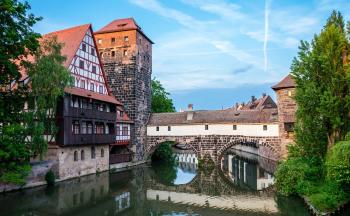Bear Markets
Bulls make money, bears make money, pigs get slaughtered. Markets can move in three directions: Up, down, sideways, and it's possible to make money either way. Just don't be that greedy pig which takes on unreasonable risk.

If you run from a wolf, you may run into a bear.
“In the midst of chaos, there is also opportunity” ― Sun-Tzu
Bear Markets and Bears
Bear markets and literal bears are not the same thing.
- Bear markets is usually seen as a sustained period of downward trending prices in stocks or other financial asset classes.
- A bear is a carnivoran mammal of the family Ursidae, adapted to a wide variety of habitats. A bear has a huge body, logs for legs, a pinocchio-sized snout, comparatively tiny ears, deadly paws, and, this one is important, analogically speaking: a short tail. When the bears attack, long positions will get mauled, while shorters get to dine and feast with these apex predators. Wild bears don't dance. Only chained bears dance.
Not the same thing. Yet, there really is knowledge about literal bears that could be applied in the world of finance, and vice verca: Outdoors people and hunters might leverage trader wisdom for their own safety when out in the wild.
For bears, winter is one night. A bear can be spotted far away, but it can also appear out of nowhere, where you least expect it. Bears haven't really adopted to anthropogenic hazards, but modern humans have a rather poor understanding of the risks this apex predator poses. The risk of a bear attack is as old as the hills, but unfortunately for some bipedals, survival skills have been long since forgotten with modernity. Livermore was kinda right: There is nothing new in Wall Street. (...) Whatever happens in the stock market today has happened before and will happen again.
Once one has been bitten by a bear life is never again so sweet. If you're attempting to dine with bears, remember this: Everyone can be right or wrong. But all that really matters is that you're limiting the damage when you're wrong, to the point of being just an insignificant dent. And when you're right, oh boy, then you're right by a lot. The good times will take care of itself. Your task is to prepare of the worst of times, and be ready when the good times ends. A fatal strategy: Enjoy the best of times to the fullest, and avoid thinking and planning for the inevitable decline of prosperity.
Don't play with the bear if you don't want to be bit. Above anything else, aim for survival. Aim before it's too late. Bears, both financial bears and wild bears, share some common traits related to danger and opportunity; You never fight a grizzly. There's protection tools: bear spray, bear cages, bear alarm fences, your handgun of choice, but even today the best line of defense is to entirely avoid dangerous encounter with a bear. For clues look to the tacit knowledge of indigenous peoples. Insight can also be gained by paying attention to avid hikers. Or consider modern hunters or wild life photographers who deliberately seek out bears to capitalize on bear encounters.
The Napalese have a saying: The farmer grows the corn, but the bear eats it. Applied to finance: Grow your portfolio, but if you stay unprepared, expect the bears to take it all away.
Some days you get the bear, other days the bear gets you. If you get the bear, you can get more bears later. If the bear gets you, it's over. Game over. Bear wins.
How to Capitalize from Bears
Skilled shorters know how to make money in bear markets. Skilled traders will know how to make money in any market. The key is to don't lose much if you're wrong, and gain substantially when you're write. Actually, that's the simplified version. All you need to do is, when you're wrong, don't make it fatal, keep the game going and then you just need to keep playing until you get that one really big win. Study the richest people in the world. Many have not made steady progress, but rather they've had one big win, or just a few big wins. In one word, it's all luck. If you're the consistent winning trader, then it's less luck involved, but even then, it's substantial elements of luck involved.
This is how wildlife photographer capitalize from their bear encounters:
- Safety first. Don't get killed. Keep your distance. Don't tempt with food, don't litter. Walk, don't run. Leave the cute cubs alone. Mother is watching. Don't get too close, use a long lense instead.
- Prepare for opportunity. Lucky shots is simply a result of the photographer taking their time, learning about their gear, learning photography skills, learning about wildlife and bears, taking safty precautions, doning the hard work, then get out there, stay where the bears roam. Have a second camera, sufficient battery capacity, backup your files, prepare for failures in order to minimize damages.
- Observe. Know bears. Study their behavior. Do your homework. Focus.
- Bears are fast, use fast shutter speed.
- If you're in a group, make sure you're able to outrun the slowest member in that group. Guess why.
- No photograp is worth risking your life.
History of Bear Markets and Stock Market Crashes
- 2020 stock market crash S&P 500 dropped 34% from 3386 on February 19 to 2237 on March 23.
- 2018 cryptocurrency crash Bitcoin price peaked on Dec '17, then fell 45% on 22nd Dec '17.
- 2015–16 stock market selloff Dow fell 588 points during a two-day period.
- 2011 short-lived bear market S&P 500 down 21.58% between May 2' (1,370.58) and October '4 (1,074.77).
- 2010 flash crash at May '6, Dow suffered worst intra-day loss ever, dropping nearly 1,000 points before partially recovering.
- 2010 European sovereign debt crisis, Greece's credit rating junk, €45-billion EU–IMF bailout, triggering stock markets decline worldwide.
- 2009 debt standstill, Dubai debt deferment request caused global stock markets to drop.
- 2007–08 Financial crisis, Packaged subprime loans, credit default swaps and BOOM, global crisis, European bank failures, sharp decline in prices of stocks and commodities worldwide, devaluation of the Icelandic króna.
- 2007–2009 US bear market Dow down again, Nasdaq Composite and S&P 500 too, all suffered. Down 50%. Worst stock market crash since the Great Depression.
- 2007 Chinese stock bubble.
- 2002 Stock market downturn.
- September 11 attacks ecomonic aftermath. Global stock markets drop sharply. Caused $40 billion in insurance losses.
- 2000 Dot-com bubble US tech bubble crash.
- 1998 Russian financial crisis, causes global mini-crash.
- 1997 Asian financial crisis, mini-crash.
- 1992 Black Wednesday in United Kingdom.
- 1991 Japanese asset price bubble lasting ~20 years till at least 2011.
- 1990s recession from US Iraq invsion in Kuwait, oil price increase, Dow down 18% in three months. Recession lasted ~8 months.
- 1989 Friday the 13th mini-crash from US failed leveraged buyout of United Airlines; Rio crash.
- 1987 Black Monday US greatest stock market intraday percentage decline so far. Culminating in a bear market after over 20% plunge in the S&P and Dow.
- 1982 stock market crash, Kuwait.
- 1973–74 stock market crash.
- 1971 Brazilian Markets Crash, lasting till early-1980s.
- 1962 Kennedy Slide (a.k.a. Flash Crash of 1962).
- 1937–38 Recession
- 1929 Wall Street Crash lasting over 4 years, leading to the Great Depression.
- Panic of 1907, 1901, 1896, 1893... 1890 Encilhamento, Panic of 1884, 1873, 1866, 1857, 1847, 1837, 1825, 1819, 1796, 1797...
- 1791–1792 Financial Crisis
- 1772 Credit crisis
- 1769 Bengal Bubble
- 1720 Mississippi Bubble
- 1720 South Sea Bubble of 1720
- 1637 Tulip mania Bubble where contract prices for certain tulip bulbs peaked and collapsed. Considered the first recorded speculative asset bubble in history. That said, this was by and large not a significant economic crisis.



